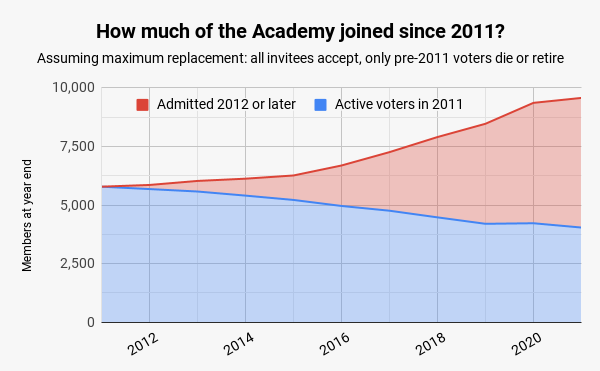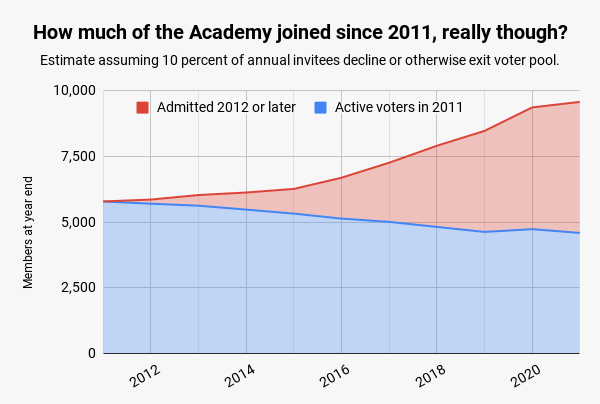Numlock Awards: The New Academy has a clear majority
What branches lost power and what branches gained it?
Numlock Awards is your one-stop awards season newsletter. Every week, join Walt Hickey and Michael Domanico as they break down the math behind the Oscars and the best narratives going into film’s biggest night. Today’s edition comes from Walter.
Hello, it’s time for the “my god, look at how substantial the Academy’s composition has changed” post!
This, to me, is everything. When we talk about wanting to “predict” the Oscars, my view has always been that the exercise is only interesting if it helps us better understand this incredibly consequential organization. It’s the reason why the model I’ve designed specifically weights recent performance over historical results, because the evidence shows that the composition of the Academy is changing so substantially that pretending it’s still 1998 is just antiquated. It’s also why I’m incredibly public about how exactly the model operates: a black box model that routinely gets things wrong isn’t just inaccurate, it’s downright boring.
Let’s start with the basics. Last year, the Academy invited 395 people. But between that new blood and the members who, shall we say, contributed to this year’s In Memoriam segment, on net the Academy is up 211 net members compared to last year.
We have a few bits of information here — invitations and the topline numbers — and with those we can infer a few things about the composition of the Academy.
(I want to give a quick shout out to Steve Pond at The Wrap, who has dutifully compiled these annual figures for many years now. These charts combine data I pulled from archived versions of the AMPAS site and his annual writeup on the subject.)
First, let’s look at what the composition would look like if every single invited person accepted, and all the exits from the voter pool are pre-2011 voters. This obviously isn’t the case — we know some people decline, and we know some of the member deaths are post-2011 invitations — but it gives us the maximum strength of the post-2011 voting bloc.
That’s an over-estimate, so what about a more realistic estimate?
This next chart assumes that 10 percent of the invitations annually decline, or otherwise exit the Academy through death or retirement from active membership. It’s our conservative estimate of the strength of the New Academy.
The weird little bump last year, you may recall, is the agents being moved from non-voting associate members into the members-at-large.
Just to lay it out, here’s where things stand based on our more conservative estimate:
Last year, based on the range of possible membership splits between the maximalist and the conservative estimates, I said we could be pretty confident that the new members were about on-par with the pre-2011 members in terms of vote count.
This year, I can very confidently say that this is an organization where a majority of the Oscar voters have been added to the Academy since 2011.
But this gain has not come evenly. I went into detail on this last year about which branches had gained and which had lost voting power. Here’s the chart I put in last year’s post, the contours are pretty much the same:
Here’s the data as of this year. This is the percentage point difference, so if a branch was 5 percent of the Academy in 2011 and they’re 7 percent now, they gained 2 percentage points. You’ll notice the actors have shed an enormous amount of voting power over the past decade, dropping from 20.3 percent of the vote to 14.1 percent as of this year. The documentary branch, by comparison, saw its vote share more than double from 2.9 percent of the Academy to 6.5 percent.
Members-at-large, as I investigated last year, are the weird little “miscellaneous” branch. They’re a lot of agents, a lot of stunt people, a lot of executives and technicians and producers and VFX people who don’t cleanly fit in the executives and producers and VFX branches.
I don’t really know what to make of the internal politics of this shift — I’m a New York-based stats guy and can only really look at the numbers here — but this seems interesting as lots of the top-line award branches are clearly losing an enormous amount of ground.
That said, following the sound branch in particular has been fascinating. I was struck reading the statement made by Mark Lanza, the head of the Motion Picture Sound Editors, in a Hollywood Reporter story by Carolyn Giardina about how ticked off the members are at being relegated to a non-broadcast award:
“The Academy made an explicit promise not to eliminate sound from the live broadcast if they agreed to the travesty of combining Sound Editing and Sound Mixing into one category,” said Mark A. Lanza, president of Motion Picture Sound Editors, in a statement to THR on Tuesday, describing this as a “bill of goods the sound branch was sold.”
Those are strong words expressing serious dissatisfaction about the treatment of the branch. That said, I don’t hear the significantly-expanded Documentary branch or the Short Film and feature animation branch complaining about their relegation.
It’s clear that the Academy’s expansion is slowing down, and I bet they top off at around 10,000ish members, leveling off over the next three years or so until they’re back to replacement-level invitations.








Congrats for being featured in Philip Bump's newsletter!